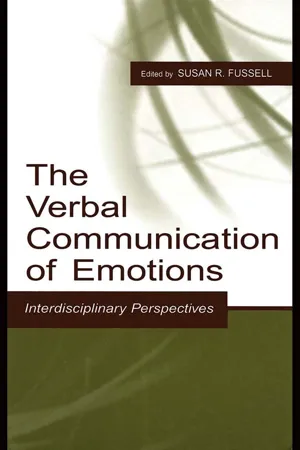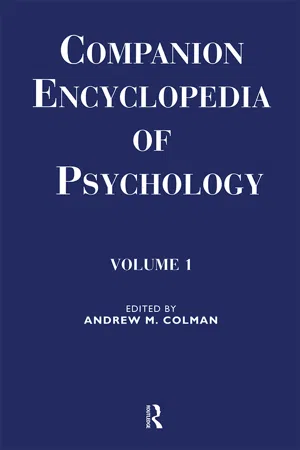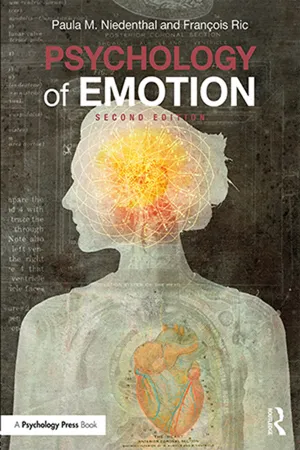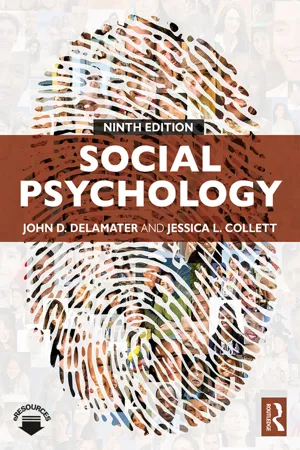Psychology
Emotional Expression
Emotional expression refers to the outward display of one's emotions through facial expressions, body language, tone of voice, and gestures. It is a fundamental aspect of human communication and plays a crucial role in conveying feelings, intentions, and social cues. Understanding emotional expression is important in psychology as it provides insight into an individual's emotional state and interpersonal interactions.
Written by Perlego with AI-assistance
Related key terms
8 Key excerpts on "Emotional Expression"
- eBook - ePub
The Verbal Communication of Emotions
Interdisciplinary Perspectives
- Susan R. Fussell(Author)
- 2002(Publication Date)
- Psychology Press(Publisher)
The emotions function as evaluating statements with respect to the topic, as well as with respect to further aspects: to other persons, their actions, ourselves, and so on. This is the essential structure of the expression of emotions and experience. Expression The communication of emotions consists to a high degree of expressions of emotions and the interpretation of these expressions. Emotional Expression, as it happens at a certain place in the interaction, is a function of underlying emotions on the one hand and, on the other hand, of display rules specifying what expressions are socially appropriate and expected in a given situation. Emotional Expression is thus understood as not exclusively a consequence of internal emotions (this is the usual view), but as determined equally from internal emotions and manifestation rules. By Emotional Expression I mean all behaviors (and involuntary physiological reactions) in the context of an interaction that are manifested by a participant with the awareness that they are related to emotions and/or that are perceived and interpreted by the interaction partner accordingly. In this way, emotion expression is conceptualized from the outset in terms of its communicative function within interaction. The relationship between expression and emotion can be determined on the following basis: In specific situations, specific behaviors and physiological reactions of individuals or groups are understood by other individuals or groups as the expression of a certain emotion of a certain intensity. These expressions may or may not actually express such an emotion - eBook - ePub
Translation and Emotion
A Psychological Perspective
- Séverine Hubscher-Davidson(Author)
- 2017(Publication Date)
- Routledge(Publisher)
4 Emotion Expression[The translation process] may very probably be the most complex type of event yet produced in the evolution of the cosmos. —Ivor RichardsThis chapter tackles the construct of emotion expression, that is, the communication of emotion-related information. The chapter defines and reviews the construct and demonstrates how people differ in the ways they express their emotions and how this can impact their well-being. The use and understanding of the construct within trait EI theory is then outlined, and examples of its application in practice are provided. Subsequently, the chapter addresses how translators express emotions in their work and the influence of individual differences in this respect. The chapter attempts to provide an answer to the following question: could emotion expression have an impact on translation performance? The final section of the chapter reviews evidence from the case study to inform the discussion.Part 1: Emotion Expression and Psychology
Emotion Expression: A Definition
In everyday language, expression is the way in which individuals communicate experience, and it is thought to play a key role in individual adjustment, therapeutic process, and social interaction (Kennedy-Moore and Watson 2001a, 7). Collier (2014, 2) defines Emotional Expression as an aspect of verbal and non-verbal communication: “People can use words to tell others how they feel, but they also convey emotions through their tone of voice and through nonverbal channels such as touch, facial expressions, body movements, and posture”. Kennedy-Moore and Watson (2001a, 4) define Emotional Expression as observable verbal and nonverbal behaviours that communicate emotional experience. Both expression and non-expression (i.e. the lack of expression) are considered to be overt manifestations of emotional experience. According to these authors, Emotional Expression is somewhat controllable and does not always correspond to the actual emotional experience (Kennedy-Moore and Watson 2001a, 4). For example, someone might be experiencing a lot of emotion but would not necessarily express it in an observable way.1 - eBook - ePub
- G. Collier, Gary James Collier(Authors)
- 2014(Publication Date)
- Psychology Press(Publisher)
This measure is not based on the ability (or inability) to convey emotions accurately but conveys the amount of overt expression a person normally displays. Expressive people are more dramatic, more "charismatic," and are more likely to choose professions such as acting, teaching, and politics, where they can put their skill to good use. Females tend to be more expressive than males, but expressiveness is only marginally related to a person's ability to communicate emotional messages through acting. The treatment of emotions by psychologists has been very uneven. The concepts of emotions and Emotional Expression have received the attention of some of the greatest minds of all times—people like Darwin, Freud, and William James. But they have been simplified and neglected by many experimental psychologists because of the belief that they were too subjective to be studied objectively. The discovery of invariant patterns across individuals and cultures makes emotions ideal candidates for rigid experimental procedures. Mislabeling can occur during self-reports but this is a second-order phenomenon superimposed on an initial prereflective experience. Tomkins (1981b) states that psychology has already gone through periods in which the emphasis has changed from motivation to behavior to cognition and predicts that the next decade or so will focus on the study of emotions. If this is so, a shift in emphasis from self-report to expressive behavior could provide a major step forward. The meaning of a message should never be neglected, but neither should it be taken at face value. Emotional Expression offers a new direction for future research on emotions. 1 It should be restressed that the term "communication" is used in the more restricted sense where a person expresses emotions through the deliberate manipulation of verbal and nonverbal cues - eBook - ePub
Companion Encyclopedia of Psychology
Volume One
- Andrew M. Colman(Author)
- 2018(Publication Date)
- Routledge(Publisher)
One of the most obvious indices of emotional experience, precisely because we are socially attuned to it, is expressive behaviour. By expression, I mean movement and sounds made by someone indicating the presence of emotion to someone else. These movements and sounds may not be deliberate or intentional, but they will still be expressive to the extent that they communicate emotional information. The face is the most important channel of Emotional Expression, partly because it is capable of a wide variety of subtly patterned movements. In addition, emotion may be expressed through tone of voice, bodily posture, and gestures.Since Darwin (1872), it has been commonly believed that at least some facial expressions are genetically programmed in humans. Evidence for this idea has come from studies that show that a small set of facial expressions are consistently identified by people coming from a large variety of cultures including some which have had little contact with westerners (Ekman & Friesen, 1971). For example, four facial expressions (anger, disgust, happiness, and sadness) posed by members of a pre-literate culture were recognized at better than chance level by American students. The evidence relating to other Emotional Expressions is less convincing. Furthermore, real-life emotional states are accompanied by continually changing facial expressions which are rarely as clearcut as those used in the studies mentioned.Emotional meaning can also be conveyed by body posture, limb movements, and so on. In fact, facial expressions are often part of more general action patterns which include postural changes and integrated movements of the whole body. Finally, emotion may be expressed vocally, in speech intonation and pitch and so on (Scherer, 1986). Research evidence suggests that the emotional meaning of contentless speech is recognized about as well as that of facial expression.Motivated action
The fourth and final component of emotion is motivated action. Emotions often seem to contain the impulse to act in certain ways appropriate to the particular emotion. For example, when angry, you may feel a strong urge to hit out at someone in some way, when in love to seek out the company of your loved one and get as close as you possibly can to him or her, and when afraid you may feel the strong desire to run away, literally or metaphorically. - eBook - ePub
- Paula M. Niedenthal, François Ric(Authors)
- 2017(Publication Date)
- Psychology Press(Publisher)
5 Expression of EmotionContents at a Glance
- The Mechanics of Facial Expressions
- Origin of Facial Expressions
- Evolution and Function of Facial Expressions
- The Question of Cultural Universality
- What Facial Expressions Convey: Emotion Readout Versus Social Motivations
- Facial Expressions Influence the Experience and Perception of Emotions
- Embodied Simulation and Emotion Perception
- Beyond the Face: Other Components of Emotion Expression
- Bodily Expression of Emotion
- Emotion in the Voice
- Combining Emotion Expression Components in Context
- Summary
Faces are possibly the most important and attention-grabbing things humans see. They are the first thing babies see when they are born, and an infant’s gaze is drawn to them (Kato & Konishi, 2013). There is a good reason for this. Until an infant develops language comprehension, it will be her caretakers’ nonverbal behavior—particularly their facial expressions—that reward her for desirable behavior, alert her to potential dangers, and signal to her that a new food or toy is safe and good. But the importance of faces and facial expressions does not go away once we learn to communicate verbally. More than any other visual stimulus, faces demand our attention, and we are quick to detect them (sometimes too quick, given how often people claim to see faces in their toast or in the clouds). It is adaptive for us to pay attention to faces, because the facial expressions of those around us provide information about their emotions as well as their attitudes toward us and the objects in our environments (see Figure 5.1 - No longer available |Learn more
- John D. DeLamater, Jessica L. Collett(Authors)
- 2018(Publication Date)
- Routledge(Publisher)
Looking across cultures, we can witness an incredible range in the expression of grief and mourning. In almost all cultures, mourning a death involves sadness and tears. Given the wide variety of funeral and bereavement practices, it can be difficult to draw clear distinctions among the practices of collectivist and individualistic cultures. However, some of the most dramatic cultural mourning acts are associated with social groups in which there are strong interdependent relationships. These practices can range from elaborate wailing episodes to the suicide of a widow or widower. Individualistic societies view these kinds of practices as extremely strange and instead carry a belief that although mourning and grief after a death is normal, there are limits. Mourners who cannot get over a death are considered unstable and may end up being isolated until they can recover.These cultural differences in the experience and expression of emotions complicate theories about the universality of basic emotions. For the most part, social psychologists agree that some emotions are universal and that they are physiologically connected to distinctive facial expressions, and yet the expression of even the most primary emotions is heavily influenced by cultural norms and can vary a great deal from place to place. If people are to communicate emotions effectively in everyday interaction, they must learn and use the display rules of their own culture. In addition, some emotions are far more conditioned on social processes than others. Social psychologists who study emotion are much more focused on these kinds of social-emotional processes than on the biological links.The Social Psychology of Emotions
A social psychological approach to emotions moves beyond the notion that emotions are simply natural reactions to things that happen in the world around us. The above discussions demonstrate that although some aspects of emotion may be biologically hardwired, others are influenced by cultural norms and experiences. Social psychologists also argue that much of our emotional experience is a matter of interpretation. When we experience a physiological reaction that is part of an emotion, before we can decide which emotion is involved, we have to interpret the physical sensation in its social context.Consider the feeling of being slightly nauseous and having sweaty palms. There are - eBook - ePub
Human Facial Expression
An Evolutionary View
- Alan J. Fridlund(Author)
- 2014(Publication Date)
- Academic Press(Publisher)
Any relations between emotion and facial display are readily explained by the mediation of social motives. It is of course possible that some facial displays may play some contributory role in felt emotion, but any scientifically useful facial feedback hypothesis must be seriously delimited so as to specify types of displays, those circumstances under which they may be contributory, the nature of their contributions, and the mechanisms by which they contribute. IS AN EMOTIONS ACCOUNT OF FACIAL DISPLAYS VIABLE? Throughout my discussion of facial displays and my comparison of the Emotions and Behavioral Ecology Views, I have treated “emotion” as a given and contested its importance in understanding faces. The studies I have discussed show that nonhuman and human faces depend upon social context, and suggest that “facial displays of emotions” are manifestations of social intent. One might question whether this is just an issue of definition. Certainly if emotion is defined broadly enough, then faces must “express emotion.” For example, why isn’t it reasonable just to say that emotions are, or can include, the expression of social motives? If we define terms such that smiling in order to be friendly while feeling happy is happiness, and crying in order to obtain succor while feeling sad is sadness, then the distinction between the Emotions and Behavioral Ecology Views becomes moot. This solution, though diplomatic, is problematic, for reasons I outline below. The Inadequacy of Action as a Criterion It is obvious, contra peripheralist views, that we can act one way and feel another. Moreover, it is now clear that the experience of emotion is separable from bodily action. We know this from several phenomena, chiefly curare experiments such as the one I cited above, in which people feel terrified despite total paralysis - eBook - ePub
- Brian Parkinson(Author)
- 2006(Publication Date)
- Routledge(Publisher)
Many of these same conclusions about emotion can also be derived from the communicational account that I have been developing in this book. According to this approach, interpersonal agendas relevant to emotional identity claims may be activated in a range of different ways, depending on the relational nature of the social situation. Furthermore the appraisal content of emotional messages can be transmitted using a wide variety of communicational media and according to many different verbal and nonverbal syntaxes. Emotional momentum also obtains in communicative emotion because adopting an emotion implies taking on a specific social identity with all its associated evaluative and action commitments. The degree of persistence of factors, in this view, depends on the level of involvement with the emotion role and the range of situations to which the relevant identity position applies.Of course, communicative and appraisal models of emotion are not necessarily competing accounts of the same set of phenomena, but rather may be seen as alternative forms of possible emotional syndrome applicable under different sets of circumstance. However, according to the present perspective, the primary meaning of emotion is as communication, and emotion produced as a consequence of individualized evaluative processes depends on prior experience of expressing identity claims in public. In other words, the communicational sequence may be the original and prototypical form of emotion on which secondary internalized encounters are based. Emotion therefore needs to be understood in terms of its functionality as well as its internal constitution. In the second part of this book, I will discuss some of the strategic and tactical purposes served by emotion within relationships, institutions, and cultures.Conclusion
Emotion theorists often consider it their task to specify the internal mechanisms that account for emotions. They typically assume that a single and integrated set of processes are responsible for generating the full range of emotional episodes (or at least a subset of those episodes delineated by a revised demarcation of the phenomenon of emotion). However, theories of emotion do not have to conform to this traditional template. Instead of allocating causality to specific mechanisms, emotion can be seen as an emergent product of the operation of the system as a whole (e.g. Barnard and Teasdale, 1991), or, more radically, as being produced by a range of different intrapersonal as well as interpersonal, institutional, and cultural processes. There may not be a single type of emotion episode with a common deep structure, but rather a range of real-life real-time phenomena, which share only family resemblances with each other (e.g. Fehr and Russell, 1984). According to such a view, it misses the point to try to develop one all-purpose explanatory account that is true for every conceivable instance of emotion. Instead, researchers should attempt to catalogue the range of sequences of events that characterize emotions as they are categorized by laypeople and try to work out what the similarities and differences between them really are. Thus, there is not necessarily any single unifying principle underlying emotional phenomena, and there may be no special additive ingredient (e.g. Arnold, 1960; James, 1898; Laird, 1974; Schachter, 1964) that makes emotion emotional rather than simply rational or cognitive. Rather, emotional phenomena may be circumscribed mainly by the functions that they serve in everyday social life.
Index pages curate the most relevant extracts from our library of academic textbooks. They’ve been created using an in-house natural language model (NLM), each adding context and meaning to key research topics.







